The Google Nexus 6P Review
by Andrei Frumusanu on December 16, 2015 8:00 AM ESTSystem & CPU Performance
The Nexus 6P comes with a Snapdragon 810 designed by Qualcomm. This is a big.LITTLE 4x A53 @ 1.55GHz + 4x A57 @ 1.95GHz SoC. As we’ve hopefully come to be very familiar with the chipset over the last couple of months, the key characteristics with which the 6P can differentiate itself from other Snapdragon 810 devices is through software optimizations. In particular the fact that the Nexus 6P comes with Android 6.0 Marshmallow should allow it to be able to showcase some improvements which we’ll dive into a bit later.
First we start by comparing performance of some of our browser-based benchmarks. These are predominantly Javascript tests which require large single-core performance out of the device’s SoCs.
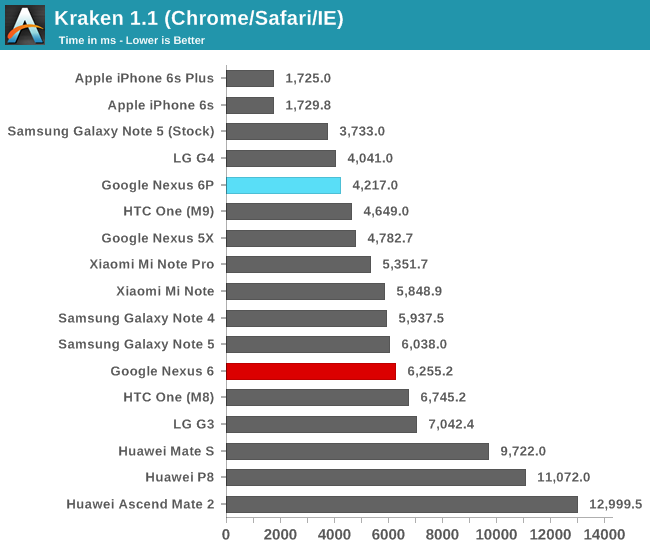
In Kraken the Nexus 6P is able to showcase a very good score that’s only beat by, oddly enough, the LG G4. As we’ve come to discover over the past year OEM browser libraries play a large role in device performance, even though we’re using the same Chrome build across different devices we see large differences in performance even within devices who employ the same SoC. It’s relatively unnerving to see this fragmentation in the ecosystem and in particular Chrome performing so differently across devices.
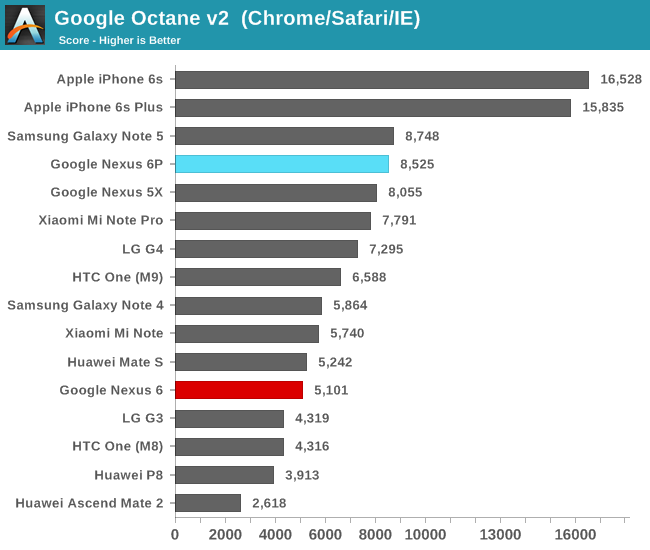
In Octane the Nexus 6P again performs very well, this time again beating our other devices such as the HTC One M9 or the Xiaomi Mi Note Pro. Among Android devices, only the Galaxy Note 5 - which on Octane is able to show equal performance as it does in its optimized stock browser - is able to beat it.
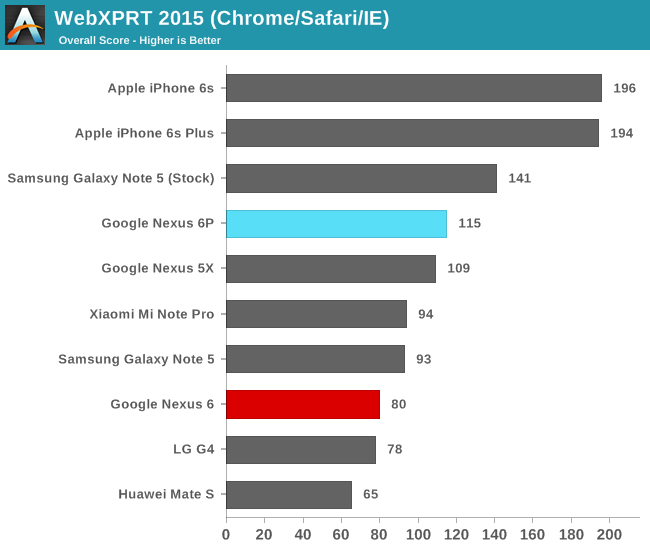
On WebXPRT again we see the 6P performs extremely well among Android devices, only being able to be beat by Samsung’s Exynos 7420 devices in the stock browser.
Continuing onto our system benchmarks, we start with Basemark OS II 2.0 from Basemark (formerly Rightware).

In the web test the Nexus 6P is yet again found at the high-end of the charts as it is able to provide good numbers. As we’ve seen in reviews such as on the Mate S it’s not necessarily raw performance that is demanded in these tests but also performance latency which plays a big role.
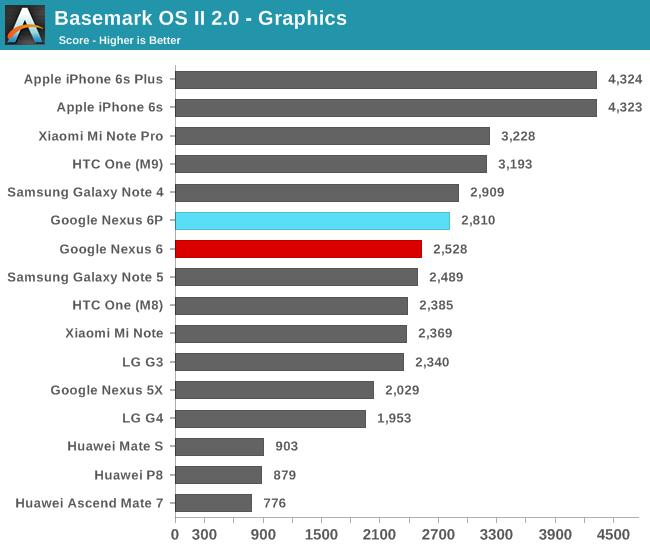
The graphics sub-test of Basemark has always been kind to the Adreno GPU so here again we see the Nexus 6P perform well, although not quite up to par with the other Snapdragon 810 devices we’ve tested in the past.
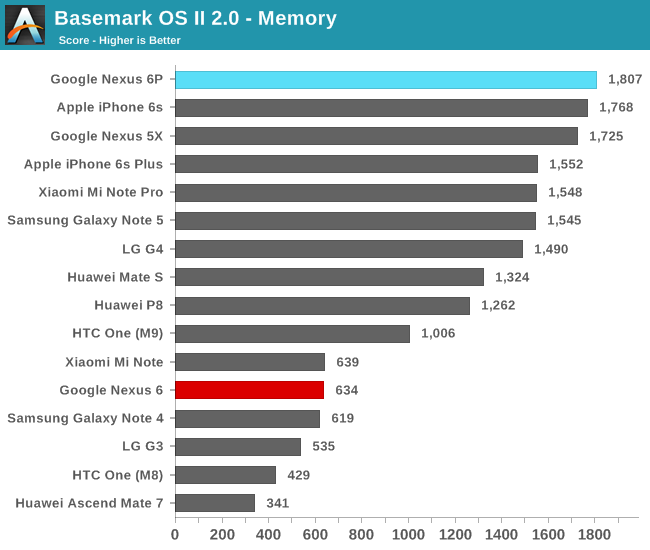
The Nexus 6P comes in a surprising first place on Basemark OS’s memory test. Again this is a mainly NAND-limited test but in contrast to our other synthetic test, performance and access patterns try to simulate more real-world applications.
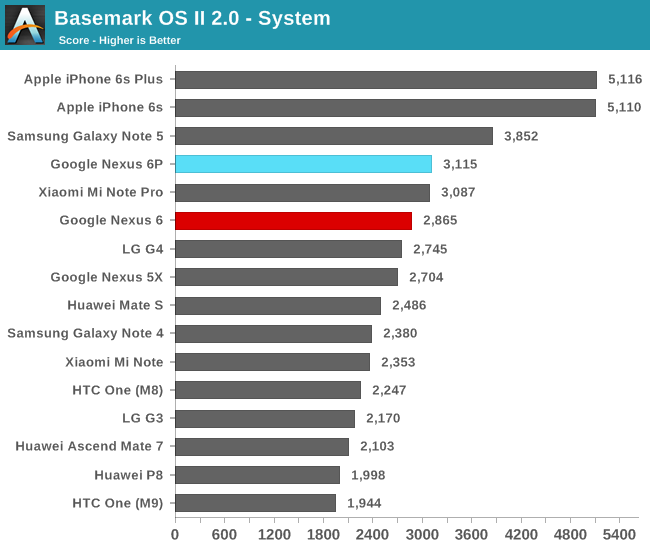
While the other tests try to test more realistic workloads, the system benchmark is all about measuring peak performance in a given set of scenarios. Here the Nexus 6P fares similarly to the Xiaomi Mi Note Pro but falls behind Exynos 7420 devices such as the Note 5.
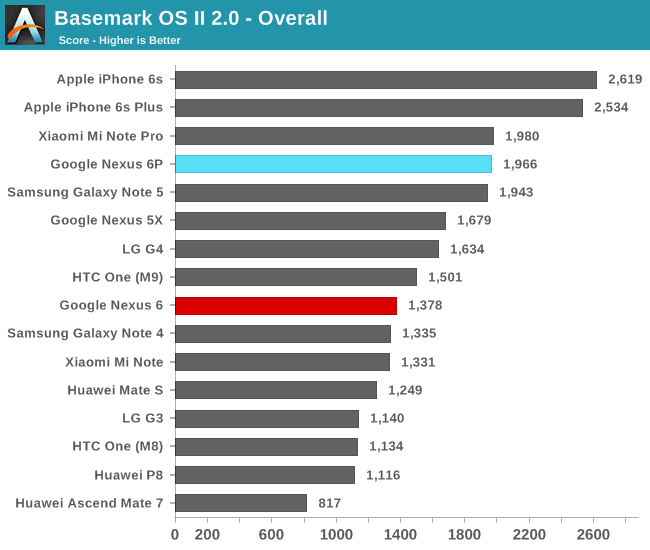
While I’m not a great fan of overall aggregate benchmark scores, we still see the Nexus 6P among the top of today’s currently available Android devices.
Moving on to PCMark from Futuremark, we’ll use a suite of tests that not only try to mimic real-world usage patterns, but actually make use of APIs that we currently find in use by many day-to-day applications.
Starting with the web browsing test we find the application use Android’s built-in WebView container which relies on OS-dependent components.
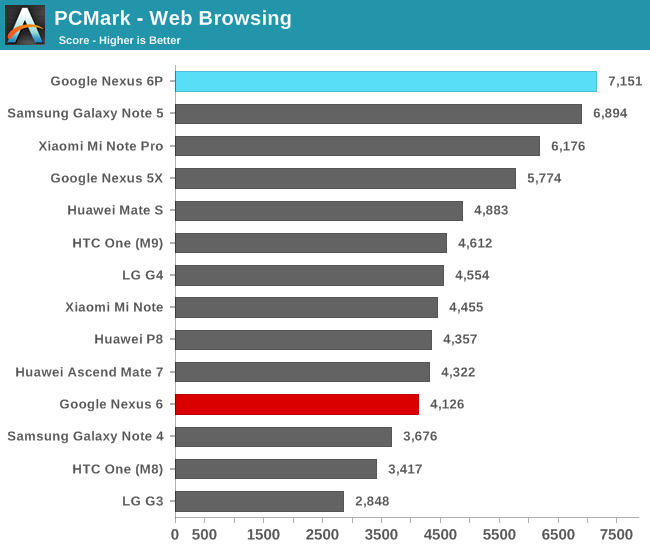
Here we see the Nexus 6P lead performance, slightly beating the Note 5. We’re also likely seeing advantages due to Android 6.0 as the Mi Note Pro, our other device with the Snapdragon 810 lags over a thousand points behind.

On the video playback score the Nexus 6P comes in towards the middle of the pack. The video test is a benchmark of both the video decoding hardware and software layers of the device, as well as the NAND speed, as fast seeking through the video is performed to test out how rapidly the device can resume playback.
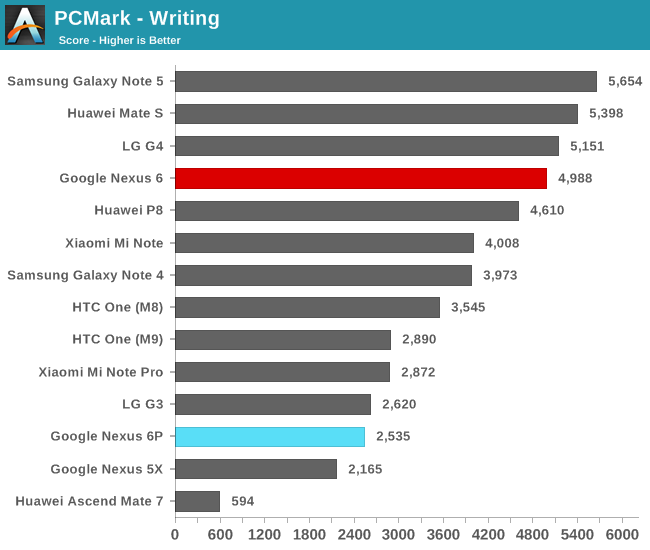
Now onto the writing test we come to one of the larger mysteries of the new Nexus 6’s performance. Both the Nexus 5X and the 6P seem to have large issues with PCMark’s writing test. The test itself consist of text manipulation and some file I/O, but most importantly it’s that this is purely a Java based test. Due to the way Android is architected, this means the code is handled and executed by the Android RunTime (ART). Futuremark have done a fantastic job in creating a test-case which is very sensitive to performance differences in the runtime.
At first when seeing these scores I thought that this was a side-effect of Android 6.0’s new big.LITTLE optimizations (which we’ll get back to in a later section), but even after turning those settings off the scores remained the same. After testing some other Java-based benchmarks I came to the conclusion that this has to be a software issue.
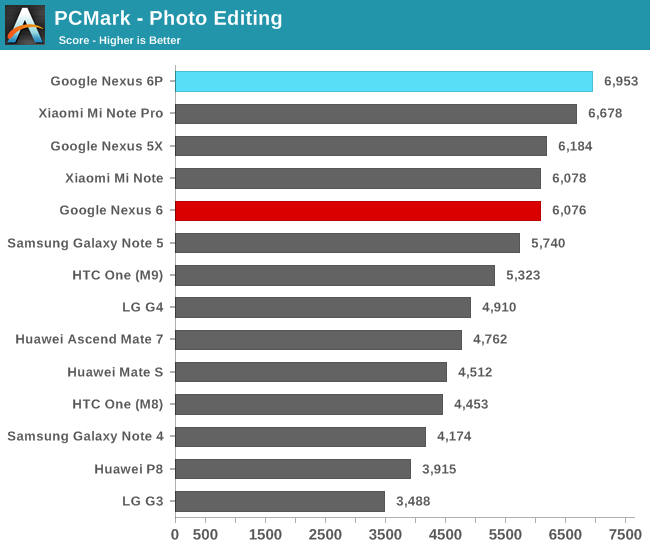
The photo editing uses RenderScript kernels to apply image processing on a set of pictures. With help of a powerful GPU the Nexus 6P performs top of the class
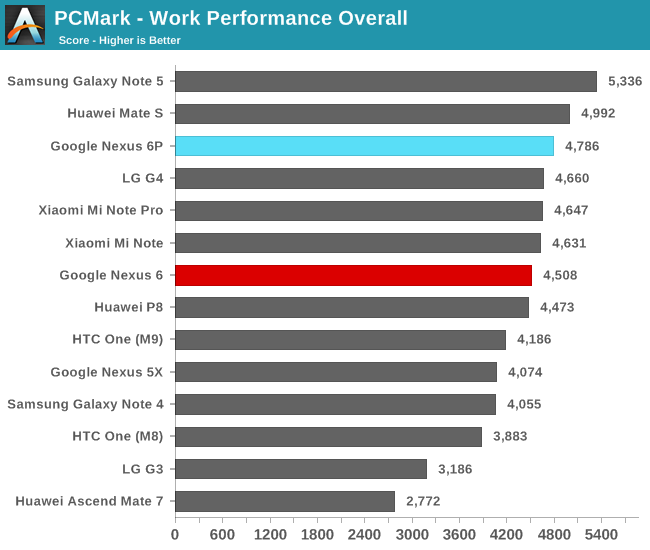
Due to the disappointing writing sub-score the Nexus 6P ends up third in the overall PCMark work performance score. Nevertheless, this is a good showing for the Snapdragon 810 device as it manages to slightly beat the Mi Note Pro and the HTC One M9.










219 Comments
View All Comments
N8SLC - Monday, December 21, 2015 - link
The brightness slider is available immediately with a two finger pull down of the notification bar. Please update article accordingly.TheinsanegamerN - Monday, December 21, 2015 - link
Still waiting for a nexus phone with a removable battery to replace my note 4.blzd - Friday, December 25, 2015 - link
That might be a wait your children's children might have to take up for you.vacaloca - Tuesday, December 22, 2015 - link
Thanks for the review. I was thinking about getting the 6P, but this review is actually making me think the 5X is the better option in terms of the screen (even though it defies all the other commentary I've seen on this)I do have one suggestion for future reviews. The charge time graphs, while okay on their own, do not take into account that these devices have bigger/smaller capacity batteries. Perhaps the better idea is to normalize this graph by battery capacity... in that case it would show the phones that charge the fastest, which perhaps would be useful to compare, especially now that a lot of devices come without removable batteries.
erple2 - Wednesday, December 23, 2015 - link
I like the idea of normalized battery charging. However, I'd take it another step further, adding something like a "charge time to use time" graph. Phones are now touting things like "15 minutes of charge for 4 hours of usage". Why not go the extra bit and add a "charge time vs. Benchmarked on screen time" kind of graph.aggiechase37 - Wednesday, December 23, 2015 - link
Count me in for a call for Anandtech to start including call quality reviews in here. It's a phone for goodness sake. For people who actually use their phone, especially for business, having the other person be able to clearly hear you is an important consideration.p51d007 - Wednesday, December 30, 2015 - link
Once the price drops CLOSER to 400 dollars, for the 64gb version, I might get one.Phones today, are OVERPOWERED, unless you are heavy into games for my use, and I'm not paying 500,600 or more for a phone. My 300 dollar Mate2, has snappy performance, GREAT battery life, excellent camera (using the camera FV-5 software that is).
Zarsus - Thursday, December 31, 2015 - link
This phone is as fragile as a glass doll, the screen cracked when I dropped my two-day old phone on ceramic tile from a height of 15 cm, yes, 15 cm, as in 0.15 meter.Maybe it's a super unlucky drop or perhaps this particular phone is defective to begin with, but all of my other phones have survived much, much, much worse drops than this and they all survived. I cannot properly express my disappointment with this phone.
Badelhas - Thursday, December 31, 2015 - link
Why is Europe price so much higher, can anyone explain?!jujufreeze - Thursday, December 31, 2015 - link
And why was the 6p not given an editor's gold choice award like the iphone 6s(+)? Perhaps Anandtech authors are hoping to get Apple jobs like Anand Shimpi?*Price. It's time to stop ignoring price. A $499 unlocked 6p is a significantly better value than an unlocked 6s with a better battery, a higher res. screen, and an extremely comparable camera. Kudos to the Nexus for ridding the ridiculous 16 Gigabyte option and starting at 32 Gigabytes. Apple is getting away with highway robbery for still offering an absurdly overpriced 16 gigabyte option.
More on the specifics...
*Battery life: iphone 6 battery is 2,750 mAh vs Nexus 6p 3,450 mAh battery. Nexus 6p is considerably faster at charging.
*Display: 2,560 x 1440 AMOLED vs. 1080p LCD. You simply can't ignore the fact the 6p is sporting more impressive technology on its screen and though it's not the best AMOLED screen, the blacks are significantly deeper. Slight edge goes to the 6p.
*Conclusion. I could go on and though the iphone 6 has a superior A9 processor and 3d Touch you can't ignore the fact that the Nexus offers in some cases better, in many cases equivalent features to the iphone 6 for a fraction of the cost.